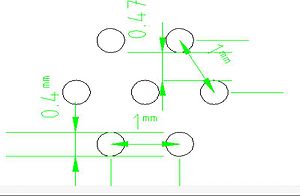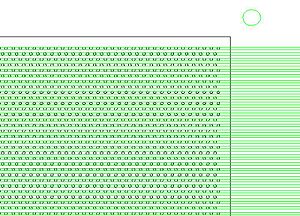Difference between revisions of "Neutron TGEM Detector Abdel"
| Line 7: | Line 7: | ||
| − | |||
| − | |||
| − | |||
| − | |||
=Resistive paste thickness-mass calibration curve= | =Resistive paste thickness-mass calibration curve= | ||
Revision as of 15:06, 3 January 2011
Haithem's logbook for developing neutron sensitive TGEM detector
Resistive paste thickness-mass calibration curve
- Aim
Studying the relationship between the mass and thickness of the resistive paste painted over 10X10 HTTGEM Foil.
- Experiment equipments and restrictions
Accurate scale (), SEM (scanning electron microscope).
SEM sample's height limit : 5 cm.
(Dr. David Peterson Assistant Professor in Anthropology,Research Scientist, Center for Archaeology, Materials and Applied Spectroscopy (CAMAS) , 157 Graveley Hall,Idaho State University)
- Procedure
Measuring the mass of Prepared samples of 0.5 thickness FR4 square plates with different surface areas as in the table below before and after painting the paste.
Studying the paste distribution and thickness under SEM.
- Experimental Data
| Plate Surface area (cm^2) (length ) | mass (g) before applying the paste | mass (g) after applying the paste | notes | |
| 1X1 | 0.2627 | 0.2634 | 0.7 | paste on both sides |
| 2X2 | 0.9776 | 0.9793 | 0.4 | paste on both sides |
| 3X3 | 2.5074 | 2.5074 | 0 | paste on one side |
| 4X4 | 4.4923 | 4.4940 | paste on one side | |
| 5X5 | 7.3261 | 7.3250 | paste on one side (paste is not uniform) |
- SEM Images
- 2x2 sample
| Image(a) | Image(b) | Image(c) | |
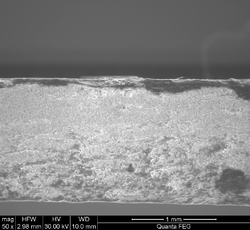 |
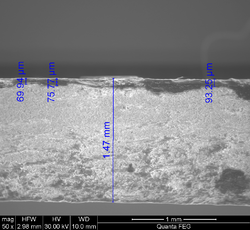 |
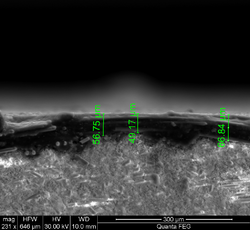
|
- 4x4 sample
| Image(1) | Image(2) | Image(3) | Image(4) | Image(5) |
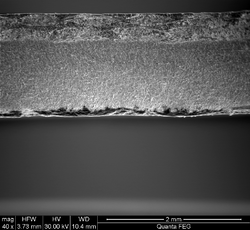 |
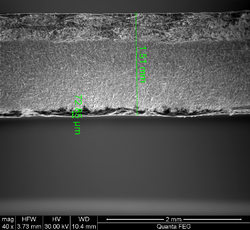 |
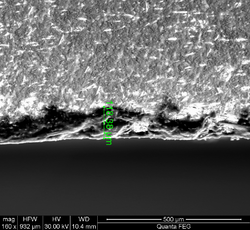 |
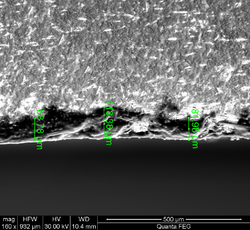 |
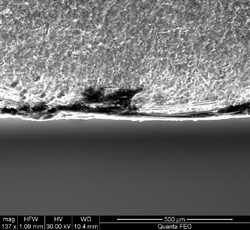
|
- Conclusions and Next step(s)
-Using SEM is accurate enough to measure the paste thickness within few micros depending on the HFW (horixzontal field width) value (determined for each image).
- Highly recommended to use a high precision scale for measuring the mass variation accurately for each samples, not only for this experiment but also for the future samples that will contain a radioactive materials.
- Preferable size for the best image is 2x2 cm with clean edges and reference line.
- The resistive paste thickness changes from one sample to another and is not unform surface within the micrometer scale, for the 4x4 sample maxmimum value measured or the paste thickness was 120 um, and the minimum was 80 um. Successivly, the 2x2 sample paste thickness was measured with a maximum of 66.84 um and mimimum 49.17 um.
- The measurements were accurate whenever the paste is distiguished from the over flow of the paste on the edge, and as the charging on the sample is the least. (When the sample was inside the SEM-chamber, a beam of electrons hit the sample and created charged areas that soemtimes ddi not make the edge image sharp enough, this is clear by comparing image (4) and image (5)).
- New samples will be prepared, all have the 2x2 cm^2 area, with a small groove on the edge to have new images by SEM, each sample will have a cerain amount of the resistitive paste, the mass of the paste accuratlely be determined (hopefully) using a high presicion scale.
Experiment Tasks timetable
| Date | Task | Notes |
| 10/20/10 | Preparing the samples in different areas | Done on time |
| 10/21/10 | painting and curing the paste, measuring the mass before and after painting the paste | measuring the mass is accurate enough, even we borrow the scale and put it in table without anything around and without being moved just for the day of the taking the data or finding a more accurate one in a more stable measuring conditions. |
| 10/22/10 | studying the samples using SEM | CAMAS facility across Alvin Ricken Drive from the Idaho Accelerator Center, at 11:00 AM |
| 10/28/10 | studying the 2x2 samples using SEM | (postpone) CAMAS facility across Alvin Ricken Drive from the Idaho Accelerator Center, at 11:00 AM |
| 11/4/10 | studying the 2x2 samples using SEM | CAMAS facility across Alvin Ricken Drive from the Idaho Accelerator Center, at 11:00 AM ?? |
RETGEM vs. THCOBRA
| RETGEM | THCOBRA |
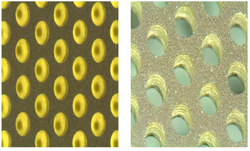 |
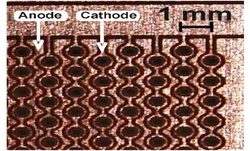
|
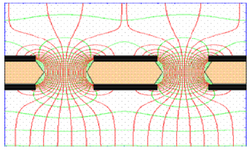 |
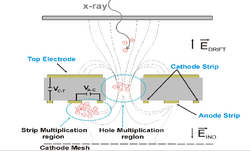
|
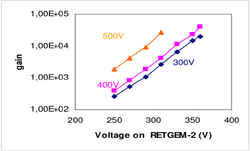 |
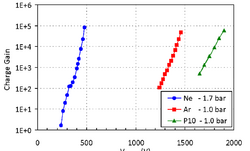
|
Comparison ENDF evaluation of U-238 neutron fission xsection and GEANT4
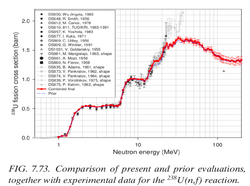 |
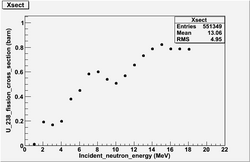 |
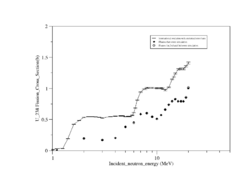
|
INTERNATIONAL EVALUATION OF NEUTRON CROSS-SECTION STANDARDS, INTERNATIONAL ATOMIC ENERGY AGENCY,VIENNA, 2007 File:U238-xsection.pdf
- absolute f_xsection in the table 7.1 p.91
| Ref. number | inxn | data description | author | citation | notes |
| 809 | 238U(n,f) | Absolute | G. Winkler et al. | 91Jülich (1991) 514 | the paper represents f_xsection ratio measurements of U_238 to Al_27, Na_24, Fe_56, Mn_56 * found in library QC770 N742 1992) |
| 810 | 238U(n,f) | Absolute | K. Merla et al. | 91Jülich (1991) 510 | * The paper represents f_xsection ratio measurements of U_238, U_235 , Np_237, and Pu_239 for 4.45 MeV, 8.46 MeV, 18.8 MeV * very accurate description for the experiment details and through the figures and the tables * found in library QC770 N742 1992) |
| 877 | 238U(n,f) | Absolute | I.M. Kuks et al. | At. Energy 30 (1971) 55 | *measured f_xsection U_238 fission for 2.5 MeV Neutrons |
| 860 | 238U(n,f) | Absolute | N.N. Flerov et al. | At. Energy 5 (1958) 657 | *title : antinutrino , Mean number of neutrons emitted in fission of U235 and U238 by 14-Mev neutrons, Mean number of neutrons emitted in fission of U235 and U238 by 14-Mev neutrons |
Done In April (edited by 04/30/10)
1.)Testing the new laminate with random holes after applying the resistive paste on both sides. Also, the trial of applying the paste was done, 0.1 inch brush is used for that to avoid covering the holes with the paste. the following procedure were taken:
a- Voltage is applied on the the foil to check the first sparking place.
b- Applying the paste carefully on the area between the holes with very small quantities.
- Result
a) Applying the paste shifts the sparking area to next neighboring one, so looks this will lead us to cover all the areas between the holes to kill the sparks.
b)A need to keep the foil under voltage to keep tracking of the sparks which lead unfortunately led to loss the voltage between the two copper layers.
Even a drop of paste got stuck in one of the holes(which has low possibility since I cleaned all the paste applied very well), or the two layers are no longer isolated from each other!
2.)Final touches on the HV-circuit are done, diagrams are done by eagle with Gerber files, the chamber is ready for redesigning.
3.)Running Th-232 fission simulation without ionization on inca and daq1. Energies 1-9MeV (inca) and 19-22 MeV(daq1) will be done by today(04/30/10).
4.)Tracking the process to get Th-232, contacting other vendors for radioactive isotopes, trying to get low cost ones.
AFCRD Reports-2010
- Done in June (edited by 07/09/10)
1.)The design for the THGEM-HV circuit is submitted to the board house.
2.) Preparing the lab for a making samples and testing the THGEM foil. Preparation includes fixing the milling machine, and finding a vendor to provide the FR4 of thickness 1 mm, coated with 17 um copper from both sides. the size of the plate should be minimum 11X 11cm to fit the inside of THGEM-detector.
3.) Finding a vendor to make THGEM foil : making 0.5 mm holes in certain pattern described in a CAD-file.
4.) One of THGEM-foil is going to be covered by Th-232, a sample of Cerium (an stable element from the same group has close to TH-232 in physical properites) was used to test the mixing process with the paste.
5.) Running the simulation using GEANT4 to calculate the fission cross for Th-232.
6.) U-238 is going to be provided, it is going to be mixed with paste as in the same procedure done by Cerium to compare the detector characteristics with one based on Th-232.
7.) Practicing repairing process for GEM-detector with Tamar.
- Results
a.) Improving the design of PC-board to hold up a voltage up to 10 kV without any sparking or short, also to include Geiger-mode APD circuit part if the idea get approved.
b.) The milling machine was sent to a repair shop in Boise, expected to start working by the end of next week from the date above.
c.) Still looking for a vendor to provide copper double clad FR4 with the same properties mentioned above.
d.)We got a Quote from a vendor to THGEM-foil but still we are waiting another two of them to compare, also checking if the vendor is able to deal with ones that has the radioactive materials.
e.) Simulation using GEANt4 needs to be improved compared with the experimental fission cross section provided by ENDF-data by creating a new ENDF-file to be a reference for GEANT4 for the Th-232 fission cross.
f.) To avoid accumulation of radioactive wastes, Nd (a stable element from the same group of U-238) will be mixed with the paste.
g.) Simulation for U-238 fission cross section started by 12 MeV energy and gave a 0.7b .
h.) Practicing on GEM gave an idea about required steps to finish THGEM-detector.
- June
- Uranium Oxide has been chosen to dope the THGEM detector's resistive paste. Procedures are being developed to apply the dopant.
- A HV distribution board has been designed for the detector and will be procured by the end of July.
- The THGEM detector's ionization vessel has been machined to accommodate the above HV board.
- Done in July (edited by 07/09/10)
A GEANT4 simulation of the 232Th(n,f) cross section from threshold to 20 MeV showed an increase with incident neutron energy but under-predicted the experimental results by a factor of 3 when the incident neutron energy was below 7 MeV. A simulation of 238U(n,f) under-predicted experiment by a factor of 2 for neutron energies below 5 MeV but was consistent with experiment above 5 MeV.
- July
- A HV distribution board has been constructed and tested to sustain high voltages up to 9 kV.
- 5 FR4 boards have been etched. Three boards were coated with resistive paste without dopant. 4 boards have been sent out for machining the 100 precision holes for preamplification.
- August
- A set of 20 holes were machined in one of the FR4 boards etched last month in order to test for HV breakdown while waiting for the remaining FR4 boards to be machined by a vendor.
- A HV test of the above board showed a voltage breakdown at 2800 Volts when the board is immersed the detectors Argon C02 ionization gas. Other groups have shown that a high voltage of 1550 Volts was sufficient to operate similar detectors. The changes made to the board for this project should not impact the HV specification of 1550 Volts. The additional Voltage which is possible with our boards will serve to increase the detector gain.
- September & October
- A set of 100 holes have been machined in each of the 5, 10X10 cm FR4 plates by the vendor.
- A test of the separation distance between the amplification board and grounded readout plane indicates that a distance of 2 mm is possible without discharges.
- The amplification stages need to be combined into a stack, tests are underway to determine the optimal separation distance between each amplification card in the stack.
- November
- Detector amplification factors was studied, two Coated FR4 plates were placed to test the voltage applied on each plate and the distance between the FR4 plates, the aim was to get 2 kV between the top and the bottom of the FR4 plate Ar/Co2 gas. Until this point we are achieving about 1.7 kV in Ar/Co2 gas, 2.5 mm is the least distance between the plates.
- Improving the read out system by adding a VFAT adapter card.
AFCRD Reports-2011
Th-232 and U-238 Activity in mCi
General information:
| Physical properties | U-238 | Th-232 |
| Half life in years | 4.468 X 10^9 | 1.405 X 10^10 |
| Decay rate per second | 4.91 X 10^-18 | 1.56 X 10^ -18 |
| Molar Mass g/mol | 238.02891 | 232.0381 |
| Activity of 2 kg in mCi | 0.68 | 0.22 |
Avogadro's number is 6.0221 X 10^23 /mol
1 Ci = 3.7 X 10^10 disintegration/ second
References
- 2010 THGEM design(s)
File:THGEM 2009 design gas efficiency.pdf
Simulations_of_Particle_Interactions_with_Matter
Voss and 3 russian references for Dy(n,x) cross sections
Media:Shalem_MSthesis_march2005.pdf
http://arxiv.org/abs/0903.3819 Dy photon gammas spectrum
http://www.ippe.obninsk.ru/podr/cjd/kobra13.php?SubentID=30974002
http://www.americanelements.com/thoxst.html
http://arxiv.org/pdf/physics/0404119
NIM_A535_2004_93[1]
File:NIM A590 2008 pg134 Eberhardt.pdf Prep Targets
Neutron cross sections for different elements Media:Neutron_cross_sections.pdf
http://www-nds.iaea.org/RIPL-2/
Media:n gamma cross sections at 25 keV.jpg
Media:n alpha cross section at 14.2 MeV.jpg
Media:ne cross section at 14 MeV.jpg
Media:high enegy fission x-section.jpg
Media:N_gamma_x-section_at_400_keV.jpg
Media:x-sections of reactions at 14 MeV.jpg
Media:n p x-section at 14.3MeV.jpg
Media: n gamma x-section at 14.5 MeV.jpg
Media: elastic x-section at 0.5 MeV.jpg
Media: n gamma x-section at 1 MeV.jpg
Media: n 2n x-section at 14.3 MeV.jpg
Donald James Hughes, Neutron cross sections, 2nd edition 1958, u.s.a atomic energy commission.Media:Neutron cross sections.pdf
File:NSAE 151 2005 319-334 Y.D. Lee.pdf
TGEM-2009 File:TGEM 2009.pdf
12 Volt power supply system.
http://www.lnf.infn.it/esperimenti/imagem/doc/NIMA_46128.pdf
http://electrontube.com.Media: rp097mono HV divier.pdf
http://www.cerac.com/pubs/proddata/thf4.htm#anchor550078
http://en.wikipedia.org/wiki/PC_board
GEANT4_Paticles_Models[2]
Resistors online store : http://www.justradios.com/rescart.html
RETGEMs
Media:Jinst8_02_p02012_THGEM_spark.pdf
- Thick GEM COBRA
Media: Nucl_Phys_B_Bidault_ novel UV photon detector.pdf
Media:Mauro micro pattern gaseuos detectors.pdf
Media:Development and First Tests of GEM-Like Detectors With Resistive Electrodes.pdf
http://www.supplydivision.co.uk/genitem.htm
Thick_GEM_versus_thin_GEM_in_two_phase_argon_avalanche_detectors (HV circuit)[3]
Stainless Steel deflection [4]
Th-Xsection references
File:Th-232 fxsection Behrens 0.7-1.4MeV.pdf
File:Th-232 fxsection Blons 1975 1.2-1.8MeV.pdf
File:Th-232 fxsection ermagambetov 0-3MeV.pdf
File:Th-232 fxsection Henkel 0-9MeV.pdf
File:Th-232 fxsection Ohsawa original.pdf
File:Th-232 fxsection pankratov 3-35MeV.pdf
File:Th-232 fxsection protopopov distancefromthesource.pdf
File:Th-232 fxsection rago 12.5-18MeV.pdf
U-238-Xsection and coating references
relative cross section and calibration samples characteristics for a well determined number of fissions per second
File:Eismont relative absolute nf induced intermediate energy.pdf
- U_238 cross section error analysis
INTERNATIONAL EVALUATION OF NEUTRON CROSS-SECTION STANDARDS, INTERNATIONAL ATOMIC ENERGY AGENCY,VIENNA, 2007 File:U238-xsection.pdf
U_238 (0.5-4MeV) and Th_232 (1-6MeV) fission cross section with statistical error.File:Th-232 U238 xsetion data ebars.txt
File:Pankratov fxsection Th232 U233 U235 Np237 U238 5-37MeV.pdf
Thorium Coating
ThF4 target for sputtering coatings
http://www.cerac.com/pubs/proddata/thf4.htm
Machining Uranium
Uranium will ignite in powder form
http://www.springerlink.com/content/rr072r52163x0833/
- coating Uranium
http://cat.inist.fr/?aModele=afficheN&cpsidt=16864172
Calorimeters/Detectors: DU sheet is in wide-scale use as an absorber material in high-energy physics research at large accelerator laboratories. The high atomic number and density of DU presents a large number of atoms per unit volume to interact with the particles emerging from collisions in these detectors. Also the slight background radiation from DU enables in situ calibration of the electronic read out devices within such detectors, thereby improving the accuracy of measurement.
http://www.2spi.com/catalog/chem/depleted-uranium-products.html
- IAEA Photonuclear Data Library [5]
- Data Acquisition
Warren_logbook[6]
Warren_Thesis [7]
Related To Gaseous Detectors
Breakdown and Detector Failure (10/21/10)
- Different kind of micro-pattern detectors
- References
1- A. Bressan, M. Hocha : NIM A 424 (1999) 321—342 File:High rate behavior and discharge limits in micro-pattern detectors .pdf
2- Fonte and Peskov IEEE 1999 :File:Fundamental limitations of high rate gaseous detectors.pdf
3- B. Schmidt: NIM A 419 (1998) 230—238 File:Microstrip gas chambers Recent developments radiation damage.pdf
Ideas
1.) Can we mix resistive paste (Encre MINICO) with TH-232. We construct a "bed of nails" to place a predrilled G-10 board with a copper border. The nails fill in the holes of the G-10 to keep the paste out. Ecre MINICO is a resistive paste used for transistors.
a.) Get some resistive paste.
http://www.leggesystems.com/p-253-elimstat-uxm-ccp.aspx
Resistive glue to compare
http://www.ellsworth.com/conformal.html?tab=Products
http://www.ellsworth.com/display/productdetail.html?productid=764&Tab=Products
http://www.ellsworth.com/display/productdetail.html?productid=2067&Tab=Products
http://www.cotronics.com/vo/cotr/ea_electricalresistant.htm
b.) mix with a metal similar to Th-232.
c.) construct bed of 0.4 mm nails. Look for 0.4 mm diameter pins.
7/31/2009
New vendor for carbon paste.
http://www.electrapolymers.com/productItem.asp?id=33
The data sheet does not show any information about the thickness of the paste.
The company has a distributor in the usa (877)-867-9668. A phone call is expected on Sat. 8/3/2009 about the availability of the product.
TGEM Mask Design
Coating U-238 or Th-232 is essential for neutron detection in the range 2-14 MeV, but THGEM contains holes that should be protected from any coating material. So, a mask is designed to cover these holes. The holes are in drilled to be on the corners of hexagonal of 1mm side length as in the figure:
The mask is made of stainless steel, 10 um laser tolerance with cut the plate to get the shape in the figure:
Please look at the following files for more details:
Make number bold black font. Add color so it is clear that they are holes in a material.
P_D
Vendor
Thick Film Screen Printers
http://www.sciquip.com/browses/browse_Cat.asp?Category=Screen+Printers
